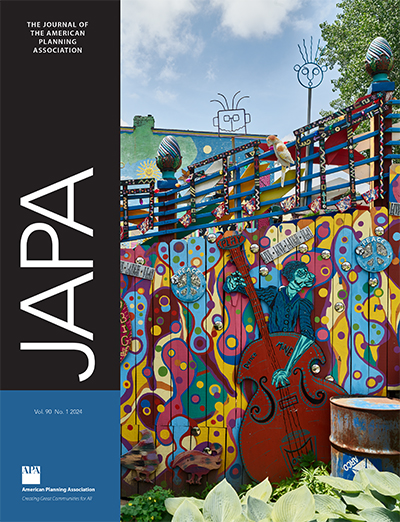在最低停车要求之后
IF 3.4
2区 经济学
Q1 REGIONAL & URBAN PLANNING
Journal of the American Planning Association
Pub Date : 2023-09-15
DOI:10.1080/01944363.2023.2248093
引用次数: 0
摘要
摘要最低停车要求(MPRs)因造成停车过剩、降低城市形态、降低住房负担能力和鼓励对汽车的依赖而受到批评。因此,许多美国城市已经开始减少或取消部分或所有地区的最低停车要求。然而,对这些政策变化的影响的现有研究只集中在停车位供应的分析上。我们调查了中西部一个小型大学城停车改革的更广泛结果,该改革取消了市中心和大学区的mpr。我们的准实验研究发现,在放松管制的地区,现场停车场的建设急剧下降,从早先需求的108%下降到只有46%,这清楚地表明,mpr已经造成了停车位供过于求。在泊车设施改革后的7年内新建的43个主要发展项目中,84%提供的泊车设施少于以前的要求,其中8个发展项目的泊车设施为零。现场停车位的减少使现有的公共和私人停车位得到了更有效的利用。此外,mpr的移除与其他政策相结合,通过增加住房密度,促进活跃的建筑临街,并将越来越多的新开发项目引导到交通丰富且适合步行的地区,帮助改善了城市形态。放松或废除停车要求将使美国城市受益匪浅。预计停车改革会遇到阻力的城市可以采取有针对性和渐进式的方法,首先取消市中心、交通走廊和其他主要地区等人口密集地区的mpr,这些地区的停车供应过剩通常会通过统一的mpr得到加强。尚佩恩(伊利诺伊州)的案例表明,有针对性的地区规模改革可能会遇到最小的反对。关键词:最低停车要求停车改革准实验研究城市发展致谢感谢伊利诺伊大学城市与区域规划系的本科生Colton Johnson和Jonah Farran在数据收集和调查方面的支持。我们还要感谢来自香槟市的Ben LeRoy(前分区管理员)、Rob Kowalski(助理规划和发展总监)、Kris Koester(行政服务经理)和来自厄巴纳市的Lily Wilcock(二级规划师)为我们的研究提供了必要的数据和有价值的见解。补充材料本文的补充数据可在https://doi.org/10.1080/01944363.2023.2248093Additional information网站在线获取。作者简介:rirang SOHONI (ssohon3@illinois.edu)是伊利诺伊大学厄巴纳-香槟分校城市与区域规划系的博士生。Bumsoo LEE (bumsoo@illinois.edu),伊利诺伊大学厄巴纳-香槟分校城市与区域规划系副教授。本文章由计算机程序翻译,如有差异,请以英文原文为准。
After the Minimum Parking Requirement
AbstractProblem, research strategy, and findings Minimum parking requirements (MPRs) have been criticized for creating excess parking, degrading urban form, reducing housing affordability, and encouraging automobile dependency. As a result, many American cities have begun to reduce or remove parking minimums in some or all areas. However, existing research on the effects of these policy changes has focused only on the analysis of parking supply. We investigated the broader results of parking reform at a small university city in the Midwest that removed MPRs for downtown and university districts. Our quasi-experimental research found that onsite parking construction in the deregulated zones decreased dramatically, from 108% of the earlier requirement to only 46%, clearly indicating that MPRs had enforced oversupply of parking. Of the 43 new major developments built in the 7 years following the parking reform, 84% provided less parking than previous requirements, including eight developments with zero parking. The reduction in onsite parking led to more efficient use of existing parking stock, both public and private. Furthermore, the removal of MPRs, combined with other policies, helped improve urban form by increasing housing density, promoting active building frontages, and guiding a growing share of new developments to transit-rich and walkable districts.Takeaway for practice American cities stand to benefit greatly by relaxing or repealing parking requirements. Cities that expect resistance to parking reforms can take a targeted and incremental approach, first removing MPRs in denser areas such as downtowns, transit corridors, and other prime districts where an oversupply of parking is typically being reinforced by uniform MPRs. The case of Champaign (IL) demonstrates that a targeted district-scale reform is likely to encounter minimal opposition.Keywords: minimum parking requirementsparkingparking reformquasi-experimental researchurban development ACKNOWLEDGMENTSWe are thankful to Colton Johnson and Jonah Farran, undergraduate students in the Department of Urban and Regional Planning at the University of Illinois, for their support in data collection and surveys. We are also grateful to Ben LeRoy (ex-zoning administrator), Rob Kowalski (assistant planning and development director), and Kris Koester (administrative services manager) from the City of Champaign and Lily Wilcock (Planner II) from the City of Urbana for providing us with essential data and valuable insights for this research.SUPPLEMENTAL MATERIALSupplemental data for this article can be accessed online at https://doi.org/10.1080/01944363.2023.2248093Additional informationNotes on contributorsSrirang SohoniSRIRANG SOHONI (ssohon3@illinois.edu) is a doctoral student in the Department of Urban and Regional Planning at the University of Illinois, Urbana–Champaign.Bumsoo LeeBUMSOO LEE (bumsoo@illinois.edu) is an associate professor in the Department of Urban and Regional Planning at the University of Illinois, Urbana–Champaign.
求助全文
通过发布文献求助,成功后即可免费获取论文全文。
去求助
来源期刊
CiteScore
11.00
自引率
10.70%
发文量
80
期刊介绍:
For more than 70 years, the quarterly Journal of the American Planning Association (JAPA) has published research, commentaries, and book reviews useful to practicing planners, policymakers, scholars, students, and citizens of urban, suburban, and rural areas. JAPA publishes only peer-reviewed, original research and analysis. It aspires to bring insight to planning the future, to air a variety of perspectives, to publish the highest quality work, and to engage readers.

 求助内容:
求助内容: 应助结果提醒方式:
应助结果提醒方式:


